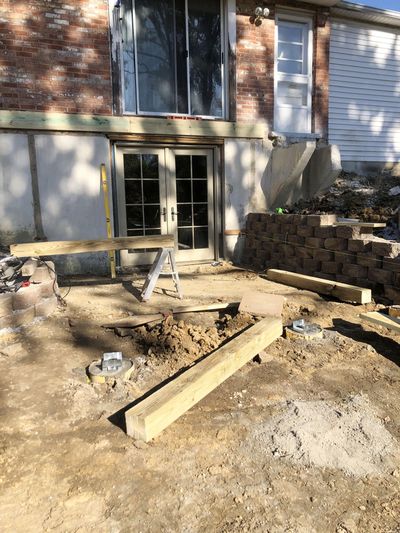Ask the Builder: Hacks for building a DIY deck

Q. I’m going to build a deck. Don’t try to stop me. I’ve got many questions for you. First, what’s the smallest size a deck can be and still have a table on it for eating? How does one figure out where to put the support posts for the beam out at the end of the deck? There’s little room for error even with a 12-inch-diameter concrete pier. What about attaching the deck to the house? – Leslie B., Albany, Georgia
A. You’re on top of your game asking all the right questions. Most decks are built too small. The deck on my own home is only 10 feet wide, but it’s 65 feet long.
I didn’t build the house or the deck. However, I did build a second deck attached to the first one three years ago. This new deck I built extends out 16 feet from the other deck, and it’s 24 feet wide.
I maintain that the smallest size deck you can build and have a table on it for four people is 12 feet by 12 feet. This assumes the table will be 4 feet in diameter.
When people are sitting in the chairs, there needs to be enough room for other people to walk behind them without being scrunched. You’ll soon discover you need 4 feet of space from the edge of the table to the deck railing to accomplish this. 4 + 4 + 4 = 12 feet!
You’d be very wise to make your deck 14 feet or even 16 feet out from your house. You’ll never regret the extra space. Deck posts need to rest on concrete piers that extend down beneath the frost line.
Many people use round, heavy cardboard tubes that resemble giant straws as the form for the pier. It’s quite common to see a 12-inch diameter pier. I prefer to use 6-inch by 6-inch posts to support all my decks.
A 12-inch concrete pier only allows you to have about 3 inches of concrete showing around the edge of a 6-by-6 wood post if you get it perfectly centered. This is not an easy task if you try to take measurements away from the house and the ground is falling away from the house.
Years ago, I discovered a very simple way to determine the location of deck support posts. I would just bang together the outer frame of the deck. This meant I had to attach the ledger board to the house and then nail or screw together the other three joists to create the square or rectangular frame.
I’d temporarily add simple 2-by-4 legs on the two joists that extended out from the house and level the frame. Next, I’d square it up. You don’t have to know calculus or deep math to do this.
All that’s required is you have the two joists projecting out from the house the same length and whatever length the house ledger board is. Make sure the outer parallel joist is the same length as the ledger board.
Take two tape measures and extend them across the deck from the corners making a giant X. When the two measurements from each tip of the corners are the same, the deck is square.
Shift the frame until you get the measurements to be the same. Once the frame is square, nail a few 8-foot-long 2x4s at a diagonal across at least two of the corners so the frame doesn’t move.
With the frame level and square, you can now extend a level down to the ground from the two outer corners of the deck. With these two points precisely marked on the ground, you can start to locate where your posts need to be.
Your structural design may place your beam several feet in from the outer edge of the deck so a small portion of the deck is cantilevered. No matter where you locate your beam, you can see how you’ll be able to use strings on the ground now to perfectly locate the center of the concrete piers so your posts are centered on the piers.
Attaching the ledger board to your home is the most difficult part of the job. Many a person has been seriously injured in deck collapses caused by a lack of attention to detail of this extremely important structural connection.
Simpson Strong-Tie is an American company that makes a variety of metal connectors you’ll probably use to build your deck. They have a fantastic library of technical notes and drawings that show you how to use special connectors and threaded rods to ensure your new deck doesn’t pull away or drop down to the ground in the future.
Years ago, I also created a helpful drawing that’s at my askthebuilder.com website. It shows you how to flash the deck ledger board against the house. It’s the only drawing I’ve ever seen that incorporates small fire cuts on the top of the joists.
These cuts allow the deck flashing to drop down over the ledger board and have the all-important kick-out lip on the flashing. The picture can be found here: shop.askthebuilder.com/deck-ledger-flashing-detail-and-notes.
Subscribe to Carter’s free newsletter and listen to his new podcasts. Go to askthebuilder.com.